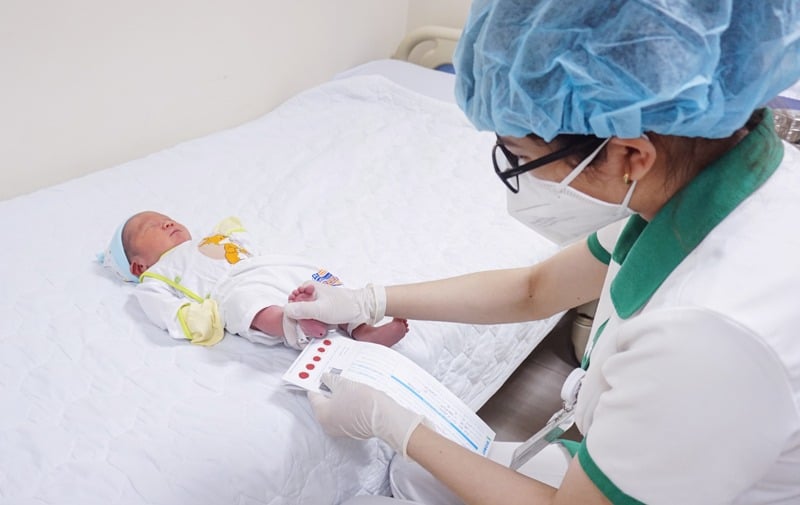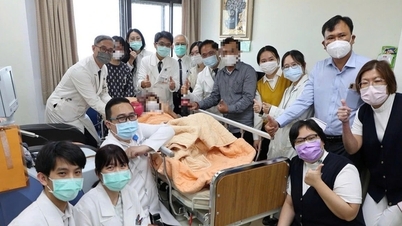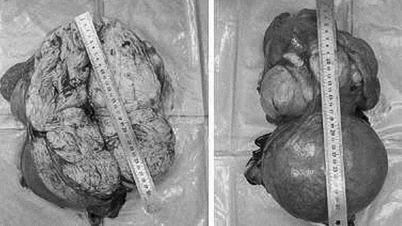Pregnant women need to screen for fetal abnormalities and genetic diseases early.
A healthy baby boy was born in Ho Chi Minh City despite being diagnosed with meconium peritonitis at 21 weeks of pregnancy, along with a rare genetic abnormality, a microduplication on chromosome number 2.
Doctors recommend that all pregnant women should be screened for fetal abnormalities and genetic diseases early. |
The baby’s mother, 32, became pregnant for the first time after undergoing intrauterine insemination (IUI) last October. First-trimester screening tests, including the NIPT (non-invasive prenatal testing), were low-risk and found no abnormalities.
However, at the 21st week of pregnancy, when performing an ultrasound at the hospital, the doctor discovered that the fetus had signs of meconium peritonitis with symptoms of abdominal effusion, multiple septa, scattered calcifications and discontinuous intestinal wall.
To find the cause, the pregnant woman was assigned to undergo amniocentesis for genetic testing. The results revealed that the fetus had a microduplication in the q12.3-q13 region of chromosome 2, a rare abnormality with not many specific statistics in the world medical literature.
According to Dr. Nguyen Thi Mong Nghi, who directly monitored the case, this repeat contains a number of genes but does not affect function or manifest as specific abnormalities.
The doctor advised both husband and wife to undergo genetic testing to determine if this was a genetic abnormality or a new mutation during conception, but the family refused for personal reasons. Therefore, the medical team continued to closely monitor the morphological manifestations and development of the fetus to come up with an appropriate treatment plan.
The situation became more complicated when at week 21, the pregnant woman was diagnosed with a risk of premature birth due to a short cervix of only 23 mm, below the safe threshold of 25 mm before week 24. The doctor placed an IUD and instructed the pregnant woman to rest and closely monitor for abnormal signs such as abdominal pain, bleeding, amniotic fluid leakage or weak fetal movement.
Throughout the pregnancy, the pregnant woman underwent weekly ultrasounds to assess the amount of abdominal fluid, bowel dilatation, calcification, amniotic fluid, and signs of fetal edema. In-depth fetal echocardiography also recorded mild tricuspid regurgitation.
According to Dr. Nghi, meconium peritonitis used to be a disease with a high mortality rate, but thanks to advances in diagnosis and surgery, the survival rate can now reach 80-92%.
Some mild cases do not require intervention, while babies with intestinal obstruction or adhesions need surgery immediately after birth. Therefore, the team of obstetricians, gynecologists, fetal medicine and neonatologists closely monitor each stage to be ready to intervene promptly.
When the fetus is 38 weeks old and mature enough, the doctor recommends an active cesarean section to avoid the risk of fetal distress or meconium aspiration syndrome, which can cause serious respiratory complications after birth.
The baby boy was born weighing 3.7 kg and was actively resuscitated with specialized tools to clean his nose, throat and airways.
The baby cried well, breathed on his own, and had rosy skin. He was transferred to the NICU for monitoring. After 48 hours, the baby ate, drank, and had bowel movements normally, and no surgery was indicated. Six days after birth, his health was stable, and he was discharged from the hospital and scheduled for a follow-up visit for further monitoring.
Chromosome 2 is one of the largest chromosomes in humans, containing many important genes. Depending on the location and size of the duplicated segment, the effects can vary from person to person. Some people with small duplicates, located outside of the functional gene region, can develop completely normally.
Doctors recommend that all pregnant women should be screened for fetal abnormalities and genetic diseases early. Adhering to a regular prenatal check-up schedule helps detect abnormalities early, thereby providing appropriate treatment, from prenatal intervention, close monitoring during pregnancy to postnatal treatment to ensure maximum safety for mother and baby.
Fighting two cancers at once
After 16 years of thyroid cancer surgery, Ms. Chi (47 years old) was shocked to be diagnosed with stage 1B endometrial cancer.
The examination results showed that Chi's endometrium had a tumor that invaded more than half the thickness of the uterine muscle layer. This is a sign of stage 1B endometrial cancer according to the FIGO classification. The tumor develops from cells of the endometrium, has invaded the muscle layer but has not spread to the cervix or ovaries.
Ms. Chi already had three children and no longer wanted to give birth, so the doctors decided to perform a total hysterectomy and two adnexectomy, and also removed 28 pelvic lymph nodes to check the level of invasion. The post-operative biopsy results confirmed that she had stage 3 endometrial cancer, a highly malignant form, although the lymph nodes were only inflamed and had no metastatic cells.
According to the treating physician, this means that the risk of recurrence and metastasis is still high, so the patient needs to continue medical treatment and be closely monitored after surgery.
Endometrial cancer is one of the common gynecological cancers in women, especially in the age group of 50-70 or postmenopausal.
In the early stages, the disease often does not show obvious symptoms and is easily confused with other gynecological disorders.
Typical signs include abnormal vaginal bleeding, especially after menopause; pelvic or lower abdominal pain; unexplained weight loss; pain during sex and persistent fatigue.
The exact cause of endometrial cancer is not yet clearly determined, however, an imbalance between the hormones estrogen and progesterone is thought to be a key factor in promoting the abnormal growth of endometrial cells.
In addition, conditions that cause ovulation disorders such as polycystic ovary syndrome (PCOS), obesity, diabetes, etc. also contribute to increasing the risk of the disease.
Depending on the stage of the disease and health status, endometrial cancer treatment may include: total hysterectomy, chemotherapy, radiotherapy, hormone therapy, immunotherapy or targeted therapy. After treatment, patients need to follow the doctor's regimen, return for check-ups on schedule, and maintain a healthy lifestyle to prevent the disease from recurring or becoming severe.
Dr. Le Nhat Nguyen, Obstetrics and Gynecology Unit, Tam Anh General Hospital, Ho Chi Minh City (formerly Chanh Hung Ward, District 8) recommends that patients should have a balanced diet with lots of green vegetables and fruits, drink enough water, reduce sugar and salt and increase light physical activities such as walking, yoga, swimming... for 15-30 minutes a day to support the recovery process.
In addition, keeping a relaxed mind and controlling weight within reasonable limits (BMI < 23) are also factors that help improve treatment effectiveness.
Elephantiasis after cancer treatment: Understand correctly to control promptly
Three years after uterine cancer surgery, Ms. Ngoc (55 years old) began to have increasingly large swelling in her left leg, making it difficult to walk and greatly affecting her daily activities. Correctly diagnosing the lymphedema condition helped her treat it effectively with compression bandages, without surgery.
Previously, Ms. Ngoc had undergone a hysterectomy and pelvic lymph node dissection, combined with chemotherapy for uterine cancer. Two years after treatment, her left leg began to swell and occasionally ache.
She went to a hospital and was diagnosed with lower limb venous insufficiency. She was treated with varicose vein medication and specialized stockings but there was no improvement.
By mid-2025, her left leg was almost twice as big as her right leg, seriously affecting her quality of life, forcing her to go to Tam Anh General Hospital in Ho Chi Minh City.
Master, Doctor, Specialist I Le Chi Hieu, Department of Thoracic and Vascular Surgery, said that in addition to venous insufficiency, Ms. Ngoc also suffered from lymphedema, a common complication in patients after cancer treatment, especially gynecological, breast, urinary, genital and head and neck cancers.
Lymphedema is a condition in which lymph fluid accumulates in an area of the body, causing swelling, pain, and compression of surrounding tissues. Lymph fluid, part of the immune system, circulates between the skin and muscles, and is responsible for transporting immune cells and nutrients, and removing foreign cells such as bacteria and viruses. When the lymphatic system is damaged, such as after lymph node dissection, radiation, or infection, the flow of fluid is interrupted, causing edema.
“In cancer patients like Ms. Ngoc, hysterectomy with pelvic lymph node dissection can damage or destroy the local lymphatic system. As a result, fluid cannot circulate, causing prolonged edema in the lower limbs,” Dr. Hieu explained.
Ms. Ngoc was treated with non-invasive medical methods, with compression bandages placed over her entire left leg. The compression bandages create even pressure to help drain lymph fluid back to the heart, reduce swelling, and prevent the edema from progressing.
In addition, she was instructed to perform massage and light exercises to support fluid circulation. After two weeks, the swelling in her left leg was significantly reduced, and is expected to return to normal in about three months if the treatment regimen is followed correctly.
Dr. Hieu said lymphedema can occur in any area of the body but is most common in the arms or legs.
Cancers in the abdominal and genital areas such as cervical, ovarian, endometrial, colorectal cancers... are likely to cause lymphedema in the legs. People who have had head and neck cancers may experience swelling in the face, neck or under the chin. Some patients may even experience internal swelling such as in the throat, causing difficulty breathing and swallowing.
Doctors recommend that patients who are or have been treated for cancer should proactively prevent lymphedema by protecting damaged skin areas and avoiding scratches and infections.
Keep the affected limb elevated above the heart when resting or lying down. Exercise regularly, gently, but not too vigorously, to maintain lymphatic circulation. Avoid carrying heavy objects, wearing tight jewelry, or wearing tight clothing in the affected area.
Maintain a healthy weight, reduce salt, and drink plenty of water to aid lymph flow.
Lymphedema, if not controlled promptly, can progress to chronic edema, recurrent infections, impaired mobility, seriously affecting the quality of life. Correct diagnosis and appropriate treatment help patients recover well and avoid long-term complications.
Source: https://baodautu.vn/tin-moi-y-te-ngay-78--thai-phu-can-sang-loc-di-tat-thai-nhi-va-benh-ly-di-truyen-tu-giai-doan-som-d352228.html



![[Photo] Solemn opening of the 1st Government Party Congress](https://vphoto.vietnam.vn/thumb/1200x675/vietnam/resource/IMAGE/2025/10/13/1760337945186_ndo_br_img-0787-jpg.webp)












































































































Comment (0)